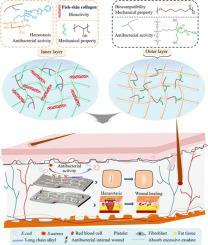European Polymer Journal ( IF 6 ) Pub Date : 2021-08-30 , DOI: 10.1016/j.eurpolymj.2021.110733 Zhongfei Gao 1 , Changming Su 1 , Chen Wang 1 , Yulong Zhang 1 , Chunhua Wang 1 , Huanhuan Yan 1 , Guige Hou 1

|
The design of novel wound dressings with favorable mechanical properties, hemostasis, inherent antibacterial function, and biocompatibility to facilitate skin wound healing and inhibit scar formation has practical significance in clinical applications. Herein, a bilayered nanofibrous membrane (PQCQS) was fabricated by electrospinning poly(ε-caprolactone) (PCL)/quaternized silicone (PQS, outer layer) and polyvinyl alcohol/collagen/quaternized chitosan (PCQC, inner layer) as wound dressings for damaged skin. The PQS nanofiber was utilized as the outer layer of the wound dressing because it combined the good mechanical property of PCL and antibacterial performance of quaternized silicone to suppress scar formation and provide a stable microenvironment for the wound healing process. The inner membrane (PCQC) exhibited hydrophilicity, biocompatibility, and hemostasis, thus facilitating wound healing. The PQCQS membranes exhibited excellent hydrophilicity, outstanding thermal stability, comparable mechanical properties with human skin, efficient hemostatic performance, and cytocompatibility. Moreover, the PQCQS membranes demonstrated a good balance between antibacterial activity and cell proliferation. Moreover, the PQCQS membranes significantly expedited the wound healing process and inhibited scar hyperplasia better than commercial ointment (MSSG and KELO-COTE) in a rabbit ear full-thickness wounds defect model. That is, the bilayered nanofibrous membranes, with excellent antibacterial activity, hydrophilicity, hemostatic performance, scar inhibition, and wound healing properties, are appropriate candidates for wound dressings.
中文翻译:

基于季铵化硅和季铵化壳聚糖的抗菌止血双层电纺纳米纤维伤口敷料用于伤口愈合
设计具有良好机械性能、止血、固有抗菌功能和生物相容性的新型伤口敷料以促进皮肤伤口愈合和抑制疤痕形成在临床应用中具有实际意义。在此,通过静电纺丝聚(ε-己内酯)(PCL)/季铵化硅(PQS,外层)和聚乙烯醇/胶原蛋白/季铵化壳聚糖(PCQC,内层)制备双层纳米纤维膜(PQCQS)作为损伤伤口敷料。皮肤。PQS 纳米纤维被用作伤口敷料的外层,因为它结合了 PCL 和抗菌的良好机械性能 季铵化有机硅抑制疤痕形成并为伤口愈合过程提供稳定微环境的性能。内膜(PCQC)表现出亲水性、生物相容性和止血性,从而促进伤口愈合。PQCQS 膜表现出优异的亲水性、出色的热稳定性、与人体皮肤相当的机械性能、高效的止血性能和细胞相容性。此外,PQCQS 膜表现出抗菌活性和细胞增殖之间的良好平衡。此外,在兔耳全层伤口缺损模型中,PQCQS 膜显着加快了伤口愈合过程并比商业软膏(MSSG 和 KELO-COTE)更好地抑制了瘢痕增生。即双层纳米纤维膜,具有优异的抗菌活性,


























 京公网安备 11010802027423号
京公网安备 11010802027423号